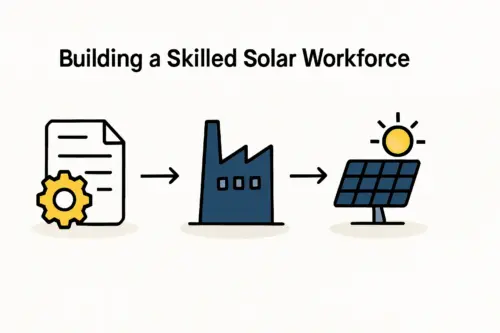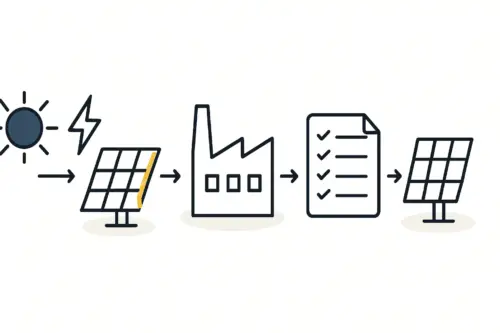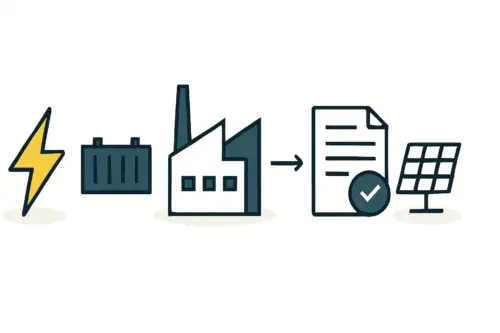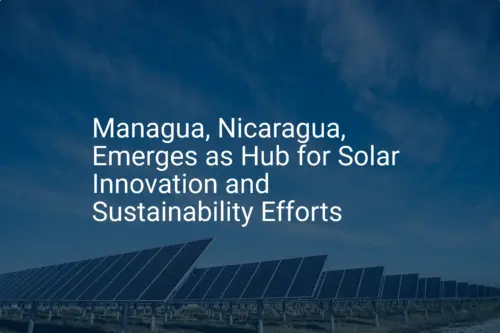Nicaragua has set ambitious goals for its energy future, aiming for 70% of its electricity to come from renewable sources by 2030. Yet, despite this forward-looking national strategy, nearly all solar modules installed in the country are imported. This discrepancy raises a compelling question for entrepreneurs: Is there a viable business case for assembling solar modules locally?
This article provides a focused analysis for business professionals considering a small-scale (10-30 MW) solar assembly operation in Nicaragua, exploring the investment requirements, market niches, and key operational considerations for launching such an enterprise in this emerging market.
The Strategic Advantage of Local Assembly in an Emerging Market
Currently, Nicaragua’s solar market relies on modules imported from global manufacturing hubs like China, as well as suppliers in the USA and Spain. Competing with these large-scale producers on price for standard, utility-scale panels is a formidable challenge. The strategic advantage for a local Nicaraguan assembler, however, lies not in volume but in agility and specialization.
A local facility can serve specific domestic needs that large international suppliers often overlook. Key advantages include:
- Reduced Lead Times: Delivering modules for local commercial or agricultural projects without the lengthy delays of international shipping and customs.
- Customization: Manufacturing modules in non-standard sizes or specifications tailored to unique applications, such as specialized architectural integrations or portable power systems.
- Supply Chain Resilience: Insulating local customers from global shipping disruptions and tariffs.
- National Contribution: Aligning the business with Nicaragua’s national energy independence goals, creating a favorable position when dealing with institutional or governmental clients.
Analyzing Nicaragua’s Market Potential and Solar Resources
The foundation of any solar enterprise is a strong solar resource, and Nicaragua is exceptionally well-positioned. The country sees average solar irradiation levels of 5 to 6 kWh/m² per day, particularly along the populous Pacific coast. This abundance of sunlight makes photovoltaic technology highly efficient and economically attractive nationwide.
While a utility-scale market exists, a small-scale assembler would likely find more immediate success by targeting underserved niches. The most promising domestic segments include:
- The Agricultural Sector: Powering water pumps for irrigation is a critical need in rural areas. Local assembly can provide durable, appropriately sized modules for these off-grid systems.
- The Tourism Industry: Remote eco-lodges and coastal resorts require reliable, independent power sources. Locally assembled panels can be integrated into hybrid systems that ensure uninterrupted power for guests.
- Commercial and Industrial (C&I): Businesses facing high electricity tariffs and frequent grid outages are prime candidates for rooftop solar installations. A local assembler can offer faster project completion and tailored solutions.
Furthermore, the government has established a supportive regulatory framework. Law No. 532, the ‘Law for the Promotion of Electricity Generation with Renewable Sources,’ provides significant tax exemptions on the import of equipment, machinery, and materials for renewable energy projects. These exemptions can substantially lower the initial capital expenditure for setting up an assembly line.
Key Investment and Operational Considerations
Starting a solar module assembly line does not require the vast capital investment associated with manufacturing silicon cells from scratch. The business model focuses on assembly, which is a much more accessible entry point into the industry.
Initial Investment Outline
The total investment required for a solar panel factory on a 10-30 MW scale typically falls within a manageable range for established entrepreneurs. A preliminary breakdown includes:
- Machinery: The core of the investment, including stringers, laminators, and testers. Sourcing semi-automated turnkey solar manufacturing lines is a common strategy for new entrants.
- Facility: A suitable industrial building of approximately 1,500–2,500 square meters is needed to house the production line, warehousing, and offices.
- Initial Bill of Materials (BOM): A significant portion of working capital will be allocated to the first batches of raw materials.
- Labor and Training: A staff of 20–30 employees is typical for a line of this size.
The Operational Framework
The assembly process itself is a straightforward, well-defined sequence. The solar panel manufacturing process involves sourcing and combining key components. A local operator in Nicaragua would import these specialized materials and handle the value-adding assembly steps locally.
Ready to make big Profits?
The solar Industry is Booming
WE HELP NEWCOMERS to the solar industry start their own solar module production line. Customers can make BIG PROFITS by selling modules and finding investors, without wasting money and time on things they don't need!
Understanding the supply chain is critical. The main components in the bill of materials (BOM)—such as solar cells, tempered glass, EVA encapsulant, and backsheets—are not produced in Nicaragua and must be imported from established global suppliers. Building strong relationships with these suppliers is essential for consistent quality and pricing.
Addressing the Primary Challenges for a New Entrant
While the opportunity is clear, prospective investors must be prepared for challenges inherent to an emerging market.
- Skilled Labor: Finding technicians with direct experience in PV manufacturing will likely be difficult. The business plan must include a robust training program, often delivered by the equipment supplier. Based on experience from J.v.G. turnkey projects, this initial training period is a critical factor for ensuring long-term quality and efficiency.
- Logistics: Managing an international supply chain requires expertise in import procedures, customs clearance, and inventory management to avoid costly production delays.
- Quality and Certification: To build trust in a market accustomed to established international brands, achieving certifications like IEC 61215 and IEC 61730 is highly recommended. This demonstrates a commitment to quality and reliability, even if the primary focus is the domestic market.
Frequently Asked Questions (FAQ)
Is a 10 MW assembly line large enough to be profitable?
Yes, profitability at this scale is achieved by focusing on niche, higher-margin products rather than competing on volume. Custom-sized panels for specific architectural needs or robust off-grid modules for agriculture often yield better margins than standard panels sold as commodities.
Do I need an engineering background to run such a facility?
A strong business and project management background is often more critical than a technical one. The key is to partner with reliable technical experts or consultants who can oversee the production process and quality control, allowing the entrepreneur to focus on strategy, sales, and operations.
How long does it take to set up a small-scale assembly line?
A typical timeline, from final planning and equipment ordering to the first module coming off the line, is between 9 and 12 months. This can be influenced by factors such as facility readiness, equipment delivery lead times, and local permitting processes.
What is the main difference between assembly and manufacturing?
Module assembly involves putting together pre-made components (cells, glass, frames, etc.). Full-scale manufacturing includes the highly complex and capital-intensive process of producing the solar cells themselves from raw silicon. For new entrants in markets like Nicaragua, assembly is the far more practical and financially viable starting point.
Conclusion and Path Forward
This analysis shows that a well-planned, small-scale solar module assembly line in Nicaragua is a viable and strategic business venture. The country’s high solar resources, supportive government policies, and growing demand in underserved sectors create fertile ground for a local manufacturing presence.
Success hinges not on attempting to out-produce global giants, but on intelligently serving the specific needs of the domestic market. By focusing on agricultural, tourism, and commercial clients who value customization, reliability, and shorter lead times, a local assembler can build a defensible and profitable niche. The path forward requires a detailed business plan, the right technical partnerships, and a clear understanding of the unique opportunities within the Nicaraguan market.









